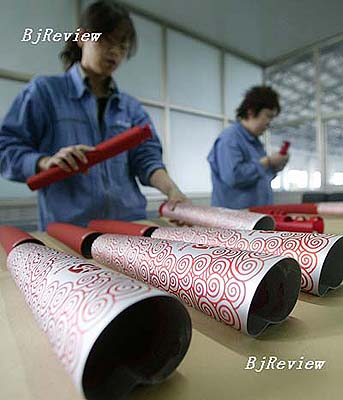|

The Beijing Olympic torch relay, which is due to start next March, will cover five continents and last a total of 130 days, making it the longest torch relay route with the largest number of participants in modern Olympic history. It will also be the first Olympic torch relay to reach the peak of the Qomolangma, or the Everest, the highest point on land at 8844.43 meters above sea level.
When the Beijing Organizing Committee for the Games of the XXIX Olympiad (BOCOG) first conceived the idea of having the torch ascend Qomolangma, BOCOG officials were not sure whether the mountain's harsh natural conditions could be overcome. Even on a benign weather day, the wind on the Qomolangma can blow a gale. Bright sunshine one moment can quickly turn into a downpour of hailstones the next.
Lack of oxygen on the mountain and its thin air pose a hindrance to keeping the Olympic flame burning. To ensure that the torch functions despite the challenges, technicians in charge of developing the burning system have designed it to stay alight in winds of up to 65 kilometers per hour and rainfall up to 50 millimeters an hour, and to withstand temperatures as low as 40 degrees centigrade below zero.
Xue Li is Vice President of the China Aerospace Science & Industry Corp., which developed the torch burning system. "The Olympic torch will burn beautifully on the highest mountain Qomolangma," he said in Beijing in October. "We feel proud that the Olympic torch for the 2008 Olympics can have a heart developed by Chinese scientists."
China Aerospace Science & Industry Corp. allocated the task of designing the burning system to its subordinate company Aerosun Corp. The Nanjing-based company had previously made bronze sculptures, including the 34-meter-tall Tian Tan Buddha in Hong Kong, the world's tallest outdoor-seated bronze Buddha. Kang Qingsheng, an engineer at Aerosun Corp. who participated in the process of building the torch from scratch, said, "The same principle was adopted to keep the torch flame flaring on the Qomolangma as to keep rocket motors flaring in thin air, so we were confident about our expertise in this field."
However, Kang admitted that they had underestimated the difficulty of their task. The small torch, measuring 72 cm long and weighing 985 grams, posed many technical problems even for the experienced engineers of Aerosun Corp.
In April, designers from China PC giant Lenovo, an International Olympic Committee worldwide sponsorship TOP program participant, won the design bid for the Olympic torch after beating 387 other bids. The red and silver torch incorporates Chinese tradition and modern elements, resembling an ancient scroll and featuring the graphic of a "lucky cloud," on which deities ride in Chinese mythology. The paper scroll shape of the torch, which symbolizes the fact that China invented papermaking technology, posed special technical difficulties for the manufacturers due to its asymmetry.
"How to accurately cast the shape of the torch as the designers had designed was the biggest challenge for us," said Sa Shiguo, Chief Engineer on the manufacturing of the torch. He said the shell of the torch is only 0.8 millimeter thick due to the demand to make it light in weight. The unusually thin shell made casting the torch particularly difficult. After a number of experiments the manufacturing team solved the problem by using a combination of multiple casting methods.
China Aerospace Science & Industry Corp.'s successful bid to design the torch burning system is attributable to the company's strong expertise in designing burning systems for rockets. "One obvious disadvantage of the traditional torch was the fluctuations in flame length due to fluctuations in the gas supply," said Hu Ningsheng, Vice President of Aerosun Corp. "Besides making a stable flame, we still had to overcome more technical challenges to enable the flame to be lit and flare strongly on the snow-capped Qomolangma."
Sa said regular torches cannot stay alight in the extremely low temperatures and thin air found on the Qomolangma. Engineers used the company's expertise in designing rocket-burning systems, installing a pressure-retaining valve in the torch. "This improvement enabled our flame to stay exactly 150 mm high, and resist winds as strong as 25 meters per second and a downpour of 60 mm per hour during tests. These really harsh tests showed our torch is capable of functioning normally in any natural conditions during the real torch relay," said Sa.
The torchbearers may run against the wind or accidentally drop the torch onto the ground during the torch relay. "With the installation of a pressure-retaining valve, the flame may shake, but won't die under any circumstances," said Kang.
| 